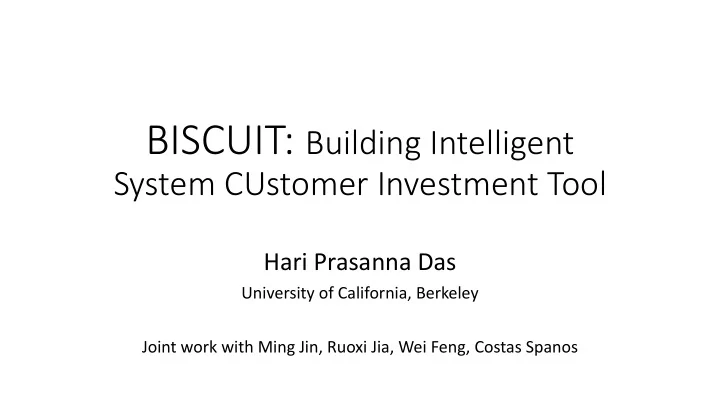

BISCUIT: Building Intelligent System CUstomer Investment Tool Hari Prasanna Das University of California, Berkeley Joint work with Ming Jin, Ruoxi Jia, Wei Feng, Costas Spanos
Design of smart buildings
Occupancy sensor selection problem • Problem: which sensor to install to enable occupancy-based lighting? Computation Lighting Cost Precision Sensor level compatible environmental sensor: CO 2 , Low Low High Yes temperature, etc. motion sensor: PIR Medium Medium Low Yes High High Medium camera sensor No • What sensors are available? What are the costs? • What are the precision? Do they require computational infrastructure? • Are they compatible? Can they be shared by other systems (e.g. HVAC)?
Smart building design lesson #1: In addition to costs, we should also consider performance and functional constraints.
Heating ventilation and air conditioning (HVAC) system retrofit evaluation • Problem: cost-benefit analysis of HVAC system retrofit plans Candidate Control Computation level Basic retrofit, no Basic control Low intelligent components smart variable air Demand-based Medium volume (VAV) box control Human-building High smart HVAC system interaction • What is the annual cost of operation for the given building profile? • Do they require additional computational infrastructure?
Smart building design lesson #2: In addition to investment costs, we should also consider available control strategies and operation cost.
“Knapsack problem” of smart buildings • Original knapsack: which items • Smart building version: which should be chosen to maximize smart building technologies profits while not exceeding the should be invested to maximize weight limit? user satisfaction given limited budget?
Challenges • Large-scale: >100K variables • Nonconvexity (discrete optimization) • Human-centric designs (soft constraints)
BISCUIT: B uilding I ntelligent S ystem Cu Cu stomer I nvestment T ools • Idea: Library + Optimization-based design space exploration User specification High-level specification Cost, energy efficiency, comfort, indoor environmental quality, privacy, security, human building interactions Library Sensor, HVAC, lighting, intelligent infrastructure, security, human building interaction Retrofit plan Simulation engine Building services Building information
Functional-level abstraction • Library: sensors, HVAC, lighting, intelligent infrastructure, etc. • Component: properties and constraints Library Items Properties Constraints Sensors Available sensor Sensing modalities (environmental parameters, sound, visual), User specifications (privacy, IEQ, models functions (presence/occupancy/indoor position/identity etc.); compatibility with intelligent detection), cost HVAC/lighting/infrastructure HVAC Intelligent/ Vendor, investment cost, maintenance cost, rate power, User specifications (intelligence traditional systems efficiency, lifespan, supported control strategies upgrade, safety), requirement on the existence of compatible sensors and Lighting Intelligent/ Vendor, investment cost, maintenance cost, rate power, intelligent infrastructures traditional systems efficiency, lifespan, supported control strategies Security Available systems Vendor, investment cost, subscription cost, lifespan HBI Available systems Maintenance cost, lifespan, control strategies, efficiency Infrastructure Available packages Vendor, cost, maintenance cost, lifespan User specifications
Formulation of intelligent building design min investment cost + annual operation cost s.t. (1) user specifications (2) technology constraints (3) operation constraints • Mixed integer linear program • Optimization over both integer and continuous variables: • Investment decision (binary) • System control strategy (binary) • Operational variables (continuous)
Case study: medium-sized commercial building renovation • Setup: a medium-sized building (40 rooms, 100 occupants) in California, USA • RSMeans cost manual and market prices
Acknowledgement • Collaborators Ming Jin Ruoxi Jia Wei Feng Costas Spanos Building Efficiency and Sustainability in the Tropics
Recommend
More recommend